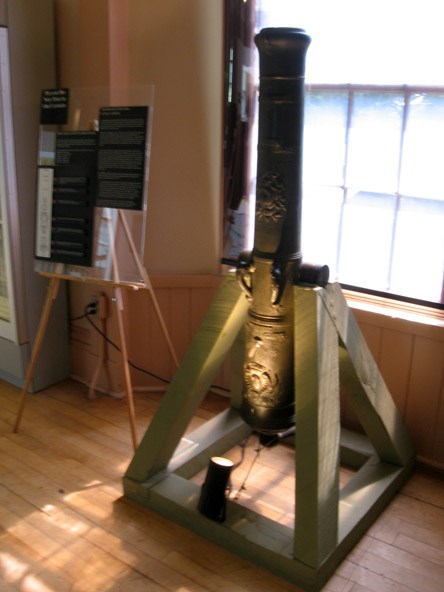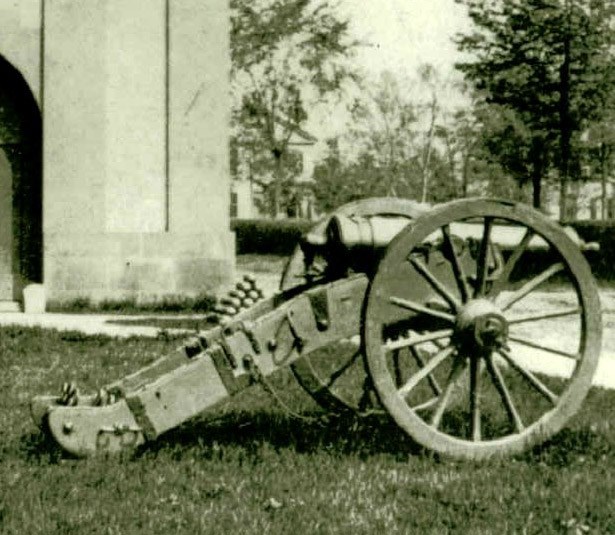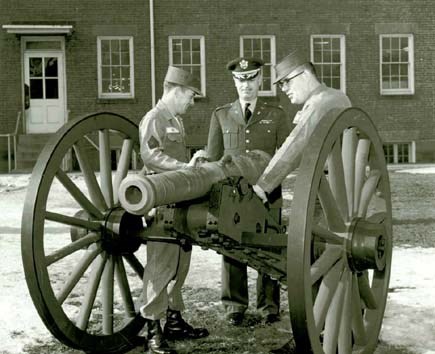
Springfield Armory NHS, US NPS THE CANNON OF THE VALLIERE SYSTEM In 1732 General Valliere standardized the French Artillery into the calibers as: 4, 8, 12, 16, and 24 pounders. Each cannon had specified lengths, proportions, and weights and even specified the methods of manufacture. Decorative details served as identifiers of each cannon. This gun, like most all known French brass Field 4 Pounders used by the Continental Army during the Revolutionary War, appears to have been rebored to the standard British 6 Pounder size. It bears the registration number "No. 82" on the left trunnion face. The cast script on the breech ring states that it was cast in Strasbourg in 1758. The cascabel and breech drawings allowed gunners to identify the size piece by a simple glance at the breech: 4-pounder= Face in a sunburst 8-pounder=Monkey head 12-pounder= Rooster head 16-pounder= Medusa head 24-pounder= Bacchus head

Springfield Armory NHS, US NPS 
"The Surrender at Saratoga," by Trumbull, circa 1778 
Springfield Armory NHS, US NPS THE FRENCH CONNECTION, AS WELL AS SPAIN It would seem quite logical that the first nation that would come to the Colonies’ aid would be England’s enemy from the last war (and, for that matter, the last 400 years). However, France, under the Bourbon monarch Louis XVI, was reluctant to openly support the Colonists’ rebellion until they saw proof that it would succeed. Officially, they sat back and waited. Nonetheless, the populace of France rode the currents of reform already rampant in Europe. The Age of Enlightenment produced authors and philosophers who expounded on the equality of humankind and the need for liberty. Among them was Pierre Augustin Caron de Beaumarchais. His pen lampooned the aristocracy in the Figaro series (later adapted into operas by both Mozart and Rossini). The upper class found his work so insulting that it was banned in the courts of France and Austria. In April of 1776, Silas Deane, congressman from Connecticut, went to France to purchase clothing, artillery and equipment for 25,000 men. In response, the French Foreign Minister sent an agent to the Colonies to examine the situation. Hearing a positive report, he then approached de Beaumarchais with an idea. The playwright would establish a fictitious firm called “Rodrigue de Hortalez & Co.,” to function as a money laundering operation. The French, Spanish and private investors would send funds allowing de Beaumarchais to purchase equipment from French military supplies that had been deemed surplus. Hortalez & Co. would then sell the equipment to the colonists for rice, tobacco and other commodities which would be sold in France. The war ships carrying these supplies arrived at Portsmouth, Rhode Island, by way of French Martinique. General George Washington noted such a shipment in a letter to General Heath dated May 2, 1777: “I was this morning favored with yours containing the pleasing accounts of the late arrivals at Portsmouth and Boston. That of the French ships of war, with artillery and other military stores, is most valuable. It is my intent to have all the arms that were not immediately wanted by the Eastern States, to be removed to Springfield, as a much safer place than Portsmouth …. I shall also write Congress and press the immediate removal of the artillery, and other military stores from Portsmouth. I would also have you forward the twenty-five chests of arms lately arrived from Martinico to Springfield.” Victory at the battle of Saratoga in 1777 was ensured by this equipment. The Americans never paid for the shipment of supplies and later questioned whether it was a gift or a sale. A portion of the debt was repaid in 1835. [edited & compiled from NPS interpretive text by Richard Colton, Park Ranger, US NPS] 
Springfield Armory NHS, US NPS |
Last updated: February 26, 2015
